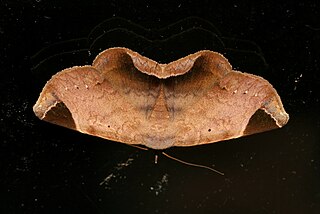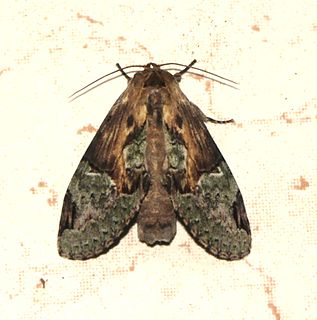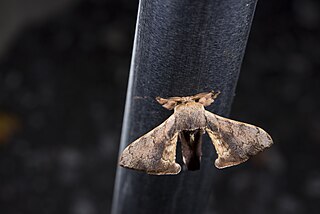
Hyarotis adrastus, the tree flitter, is a butterfly belonging to the family Hesperiidae found in South Asia and Southeast Asia.

Psilogramma menephron, the privet hawk moth or large brown hawkmoth, is a member of the family Sphingidae. It was described by Pieter Cramer in 1780. It is usually found in Sri Lanka, India, Nepal, central and southern China, Thailand, Vietnam, Indonesia and the Philippines. Psilogramma casuarinae from eastern Australia was long treated as a synonym but is now thought to be a distinct species. The introduced population on Hawaii was first thought to be P. menephron, but is Psilogramma increta.

Catopsilia pyranthe, the mottled emigrant, is a medium-sized butterfly of the family Pieridae found in south Asia, southeast Asia, and parts of Australia.

Daphnis nerii, the oleander hawk-moth or army green moth, is a moth of the family Sphingidae. It was described by Carl Linnaeus in his 1758 10th edition of Systema Naturae.

Chilades lajus, the lime blue, is a small butterfly found in India, Sri Lanka, Myanmar, Taiwan, Hong Kong, Hainan, Mangulam Island, Sulawesi and the Philippines that belongs to the lycaenids or blues family.

Jamides bochus, the dark cerulean, is a small butterfly found in Indomalayan realm that belongs to the lycaenids or blues family. The species was first described by Caspar Stoll in 1782.

Euthalia lubentina, the gaudy baron, is a species of nymphalid butterfly found in South, Cambodia, and Southeast Asia. It was first described by Pieter Cramer in 1777.

Dophla evelina, the red-spot duke, is a species of brush-footed butterfly found in Cambodia and South and Southeast Asia. Many subspecies are accepted. The species was first described by Caspar Stoll in 1790.

Nephele hespera, the crepuscular hawkmoth, is a sphingid moth described by Johan Christian Fabricius in 1775.

Psimada is a monotypic moth genus of the family Noctuidae. Its only species, Psimada quadripennis, is found in the Indian subregion, southern China, Taiwan, Myanmar, Thailand, Sri Lanka, the Andaman Islands, Sundaland, Sulawesi and Seram. Both the genus and species were first described by Francis Walker in 1858.

Hulodes caranea is a species of moth of the family Erebidae first described by Pieter Cramer in 1780. It is found from India, Sri Lanka, Myanmar, Java, Hong Kong to Queensland and New Guinea, it is also found on the Marianas and Carolines.

Eudocima phalonia, the common fruit-piercing moth, is a fruit piercing moth of the family Erebidae. The species was first described by Carl Linnaeus in his 1763 Centuria Insectorum. It is found in large parts of the tropics, mainly in Asia, Africa and Australia but introduced into other areas such as Hawaii, New Zealand and the Society Islands. It is one of major fruit pests in the world.

Pergesa is a monotypic moth genus in the family Sphingidae first described by Francis Walker in 1856. Its only species, Pergesa acteus, the green pergesa hawkmoth, was described by Pieter Cramer in 1779.

Parasa lepida, the nettle caterpillar or blue-striped nettle grub, is a moth of the family Limacodidae that was described by Pieter Cramer in 1799. It is a native minor pest found in the Indo-Malayan region, including India, Sri Lanka, Vietnam, Malaysia and Indonesia. It is an introduced pest to urban trees in western Japan.

Chadisra bipars is a moth of the family Notodontidae. It was described by Francis Walker in 1862 and is found in the Indomalayan realm.

Semiothisa eleonora is a moth of the family Geometridae. It is found in south-west Asia, including India, Sri Lanka and Taiwan.

Calyptra minuticornis, the vampire moth, is a moth of the family Erebidae. It has been found in Indonesia, Java, India, Sri Lanka, and Australasia.

Trilocha varians is a moth in the family Bombycidae described by Francis Walker in 1855. It is widespread in the Oriental region from India, Sri Lanka, China, extending to Taiwan, the Philippines, Pakistan, Sulawesi and Java.
Phalacra vidhisara is a moth in the family Drepanidae. It was described by Francis Walker in 1860. It is found in Sri Lanka and India.
Stenopsestis alternata is a moth in the family Drepanidae. It is found in Sikkim in India, Nepal, Myanmar, Thailand, and the Chinese provinces of Gansu, Hubei, Jiangxi, Hunan, Guangdong, Guangxi, Sichuan, Yunnan and Tibet.

















